
British postcard by Philco, Series no. 1046/4. Photo: Dover St. Studios.
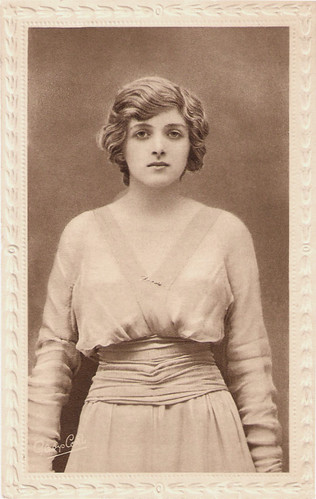
British postcard by Philco, Series no. 1134/1. Photo: Wrather & Buys.

British postcard, Series no. 2896/1. British Manufacture. Photo: Wrather & Buys. The "lampshade" dress must have been inspired by Paul Poiret's famous design of 1913.
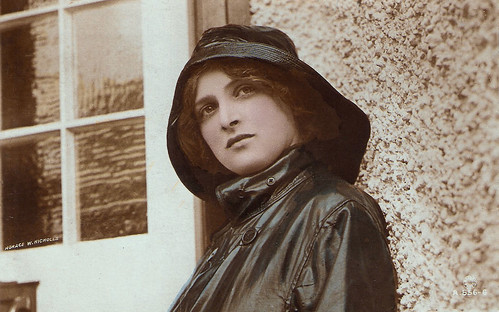
British hand-painted postcard by Rotary Photo, London, no. A.556-6. Sent by mail in 1915. Photo: Horace W. Nicholls.

British postcard in the Famous Oldies series by Collectorcard, Croydon, no. C9005. Photo: The National Film Archive. Gladys Cooper and Ivor Novello in The Bohemian Girl (Harley Knoles, 1922).
Gaiety Girl
Gladys Constance Cooper was born in London, England, in 1888. She was one of the three daughters of journalist Charles William Frederick Cooper by his marriage to Mabel Barnett.
In 1905 she had her stage debut touring with Seymour Hicks in his musical 'Bluebell in Fairyland'.
In 1907 she took a departure from the legitimate stage to become a member of Frank Curzon's famous Gaiety Girls chorus entertainments at The Gaiety Theatre in London, appearing in the successful 1908 musical 'Havana'.In 1911 she had her breakthrough in Oscar Wilde's 'The Importance of Being Earnest'.
Soon the young beauty became a popular photographic model. During World War I her popularity grew into something of a pin-up fad for the British military. From the craze for postcards with photos of actors - that ensued between about 1890 and 1914 - Cooper became a popular subject of maidenly beauty with scenes such as Juliet and many others.
In 1917 she became co-manager, with Frank Curzon, of the London Playhouse Theatre, and she ran it on her own between 1927 and 1933. At the start of her career, she was criticised for her 'wooden' performance, and she only found major critical success in 1922 with 'The Second Mrs. Thacqueray'.

British postcard by Rotary Photo, London, no. B.97-3.

British postcard by Rotary Photo, London, no. B.141-2.

British postcard by Rotary Photo, no. B 54-1. Photo: Rita Martin. Margareta "Rita" Weir Martin (1875–1958) was an English photographer, considered "one of the best British photographers of her time". Martin took portraits of many suffragists and was a suffragist herself.

British postcard by Rotary Photo, London, no. B 136-3 (handpainted real photograph). Sent by mail in Great Britain in 1918.

British postcard by Rotary Photo, no. 5.63-2.
Hollywood
In 1913 Gladys Cooper started in film. Her debut was in The Eleventh Commandment (1913). Several silent British films followed such as Danny Donovan, the Gentleman Cracksman (Walter Waller, 1914) with Thomas Meighan, The Sorrows of Satan (Alexander Butler, 1917) and The Bohemian Girl (Harley Knoles, 1922) with Ivor Novello.
In 1934 Cooper made her first sound picture in the UK, The Iron Duke (Victor Saville, 1934) starring George Arliss. She came to Broadway with 'The Shining Hour', which she had been doing in London. According to William McPeak at IMDb, "She and it were a success, and she followed it with several plays through 1938, including 'Macbeth'. About this time Hollywood scouts caught wind of her, and she began her 30-odd years in American film."
In particular, in the 1940s she played memorably in a variety of character roles and was most frequently cast as a disapproving, aristocratic society woman.
Among her best film roles were as Laurence Olivier's gregarious sister in Rebecca (Alfred Hitchcock, 1940), as Bette Davis's domineering mother in Now, Voyager (Irving Rapper, 1942), and as a sceptical nun in The Song of Bernadette (Henry King, 1943).
Her last major film was My Fair Lady (George Cukor, 1964) as Henry Higgins' (Rex Harrison) mother. For Now, Voyager, The Song of Bernadette and My Fair Lady, Cooper got Academy Award Nominations.

British hand-painted postcard, Series W878/2. Sent by mail in 1919. Photo: Claude Harris Ltd.
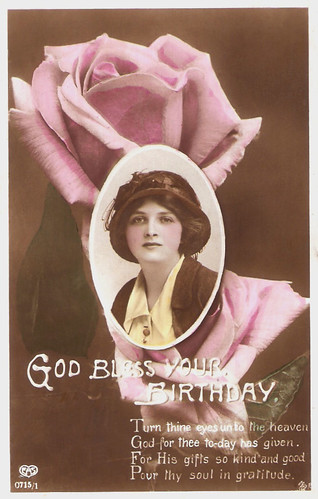
British hand-painted postcard by E.A. Schwerdtfeger & Co. (EAS), London/Berlin, no. 0715/1. Sent by mail in 1914.

British hand-painted postcard by F. W. Woolworth & Co.. Photo: Claude Harris Ltd.
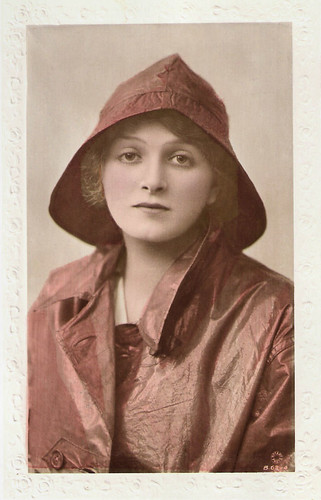
British hand-painted postcard by Rotary Photo, London, no. A.556-6. Sent by mail in 1915. Photo: Horace W. Nicholls.
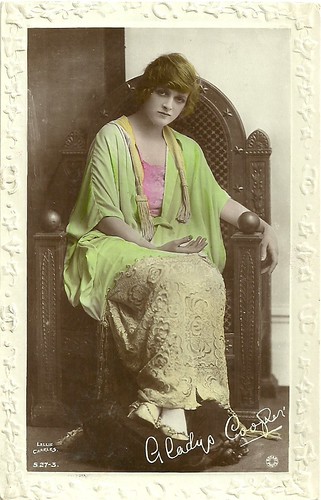
British postcard by Rotary Photo, no. 5.27-3. Photo: Lallie Charles.
Permanent Resident Alien
Gladys Cooper's last major success on the stage was in the role of Mrs. St. Maugham in Enid Bagnold's The Chalk Garden, a role she had created in 1955 in London and in 1956 on Broadway.
Through the 1950s and into the 1960s she did only a few films but she was an especially familiar face on American TV. Her role as Margaret St. Clair in The Rogues with David Niven and Charles Boyer got her a Golden Globe in 1962. She also appeared in three episodes of The Twilight Zone.
In 1967, at nearly 80 years of age, she was made a Dame Commander of the Order of the British Empire (DBE). Cooper continued to act both in film and on the stage until her death.
Gladys Cooper was married three times; to Capt. Herbert Buckmaster (two children, incl. actress Joan Buckmaster, who married actor Robert Morley); to Sir Neville Pearson (one daughter, costume designer Sally Pearson, who married actor Robert Hardy), and to actor Philip Merivale. Her stepson from her last marriage was actor John Merivale.
She lived for many years in Santa Monica, California, as a permanent resident alien with her third husband, until his death in 1946 from a heart ailment. She herself eventually returned to the United Kingdom for her final years. At the age of 82, Gladys Cooper died of a stroke, in Henley-on-Thames, in 1971.

Gladys Cooper with her two eldest children. British hand-painted postcard by Rotary, no. S 25-3. Photo: Rita Martin.

British postcard by Rotary Photo, no. S. 26-3. Photo: Lallie Charles. Lallie Charles (née Charlotte Elizabeth Martin) (1869–1919), was an Irish photographer, who along with her sister Rita Martin was one of the most commercially successful women portraitists of the early 20th century.

British hand-painted postcard by Rotary Photo, London, no. S. 27-4. Photo: Lallie Charles.

British hand-painted postcard by Rotary Photo, London, no. S. 50.3. Sent by mail in 1919.

British postcard by Lilywhite Ltd., London, no. L.E. 59. Gladys Cooper, Charles Hawtrey and J. Cranstoun Nevill as Eloise, her husband and her lover in the play The Naughty Wife (1918) by Fred. Jackson, revised by Edgar Selwyn, and produced by Charles Hawtrey at the Playhouse. The plot is about a writer, Hilary Farrington, too much involved in his writing, so his wife Eloise elopes with a notorious womanizer. The husband is very lenient, lets her leave with a trunk full of clothes, and provides their bungalow as temporal home until a divorce is settled. Yet, he menaces the lover he will kill him if he dares to dump Eloise like he did with his previous mistresses...

British postcard by Lilywhite Ltd., London, no. L.E. 60. Gladys Cooper as Eloise and Charles Hawtrey as her husband in the play 'The Naughty Wife' (1918).

British postcard by Lilywhite Ltd., London, no. L.E. 61. Gladys Cooper as Eloise opposite Charles Hawtrey as her husband in the play 'The Naughty Wife' (1918).

British postcard by Lilywhite Ltd., London, no. L.E. 62. Gladys Cooper in the play 'The Naughty Wife' (1918).

British postcard by Lilywhite Ltd., London, no. L.E. 63. Gladys Cooper in the play 'The Naughty Wife' (1918)
Sources: William McPeak (IMDb), Wikipedia, and IMDb.
This post was last updated on 23 October 2023.
1 comment:
Verry Good
Musikku
LaguOke
JokerLagu
Stafabandra
Unduhbro
Stafabandra
Post a Comment